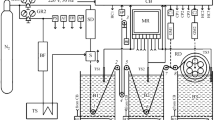Conclusions
By use of the double coagulation bath method, membranes have been made from polysulfone having an effective selective layer thickness of 2.5 µm. The limiting size of hollow fibres is as follows: external diameter, 1 mm; internal diameter, 0.6 mm. It was not possible to obtain a surface layer free of defects on increasing the diameter.
In the membranes prepared, more than 50% of the resistance to mass-transfer is concentrated in the porous layer.
It has been found that the selective layer of the membrane has a critical thickness (which depends of the nature of the polymer, the solvent, and other factors), below which selectivity begins to decrease.
In evaporation through a membrane, a dependence of the result of studies on the internal diameter — hollow fibre length was discovered.
In an experiment on evaporation through a membrane at 36 K, for the system 80% acetic acid — water, using hollow fibres a selectivity of 116 and a flux of 0.1 kg/m2 were obtained.
Similar content being viewed by others
References
Yu. I. Dytnerskii, Membrane Processes for Separating Liquid Mixtures [in Russian], Khimiya, Moscow (1975).
M. E. Goldblat and C. H. Gooding, AIChE Symp. Ser., 82, No. 248, 51 (1986).
H. H. Nijhuis, Removal of Trace Organics from Water by Pervaporation: Thesis, University of Twente, Enshede (1990).
A. Stephen, Membrane Separation in Biotechnology, W. C. McGregor (ed.) (1986), pp. 161–200.
J. van't Hof, Wet, Spinning of Asymmetric Hollow Fibre Membranes for Gas Separation: Thesis, University of Twente, Enshede (1988).
J. W. F. Spitzen, Pervaporation. Membranes and Models for the Dehydration of Ethanol: Thesis. University of Twente, Enshede (1988).
C. H. Gooding and K. G. Teague, Proceedings of the Fourth International Conference on Pervaporation Processes in the Chemical Industry, Chicago (1989), pp. 262–273.
Author information
Authors and Affiliations
Additional information
Translated from Khimicheskie Volokna, No. 3, pp. 38–41, May–June, 1993.
Rights and permissions
About this article
Cite this article
Varezkhin, A.V. Use of hollow polysulfone fibres in the process of dehydrating acetic acid by evaporation through a membrane. Fibre Chem 25, 206–210 (1993). https://doi.org/10.1007/BF00551134
Issue Date:
DOI: https://doi.org/10.1007/BF00551134



